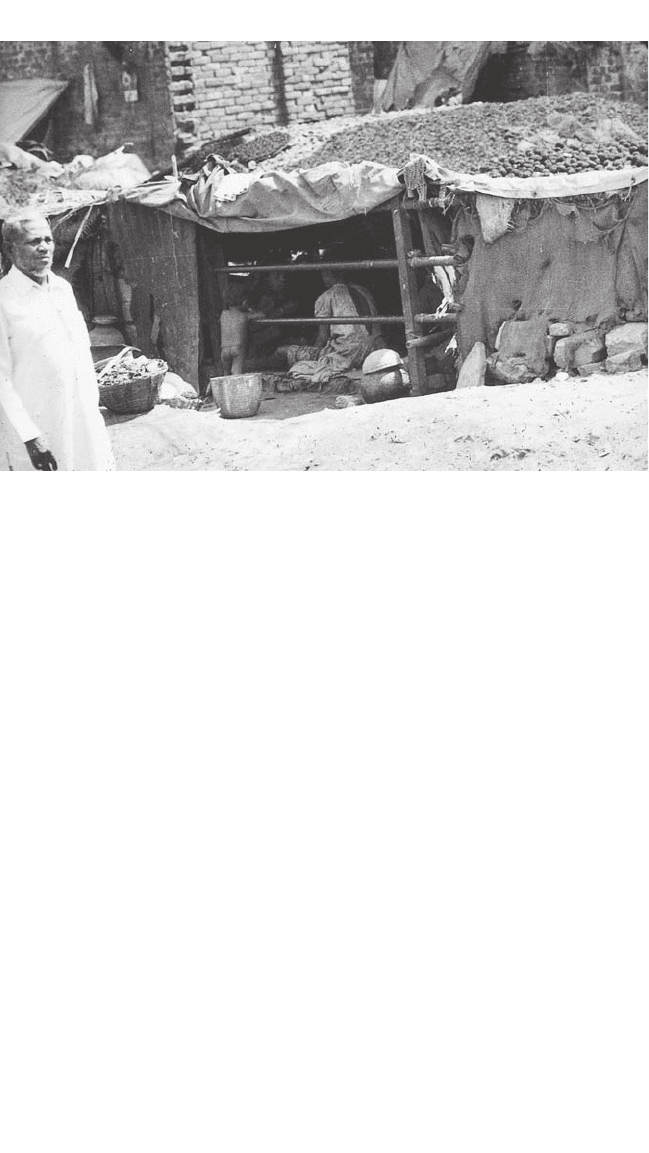Walsh J.E. A Brief History of India
Подождите немного. Документ загружается.


A BRIEF HISTORY OF INDIA
262
criticized for failing to defend the mosque, ordered the arrest of six prom-
inent Hindu nationalists, among them Advani and the head of the VHP,
on charges of inciting communal violence. Rao’s government banned the
RSS, the VHP, and the Bajrang Dal, sealed their offi ces, and prohibited
any further activities. The Congress (I) imposed president’s rule in Uttar
Pradesh, Madhya Pradesh, Rajasthan, and Himachal Pradesh, dismissing
all their BJP state governments.
But Rao’s coalition government was already weak, and his determina-
tion to punish participants in a popular Hindu cause had only a limited
duration. All the Hindu nationalist leaders were released by mid-January
1993. Fewer than 4,000 Sangh Parivar participants were arrested nation-
ally, among them 1,500 RSS, VHP, and Bajrang Dal members in Uttar
Pradesh and almost 1,000 in Madhya Pradesh. Within weeks of the
center’s orders banning the Sangh Parivar groups, state courts began to
modify them. In 1993 the Delhi High Court lifted the ban on the RSS and
Bajrang Dal (while maintaining it on the VHP for two years because of its
members’ infl ammatory speeches). By January 1993 the Allahabad High
Court was allowing Hindu worshippers to enter the mosque grounds to
view images in the makeshift temple there. A nationwide opinion poll in
January 1993 showed that among North Indians more than 52 percent
approved the mosque’s demolition. In South India, in contrast, only 17
percent approved the demolition, while 70 percent approved the arrest of
the BJP leaders and the banning of their organizations.
As the Babri Masjid campaign drew to an uneasy close, the Indian
political scene was focused on the BJP’s growing challenge to the assump-
tion of secularism at the core of the nation. As parties prepared for the
1996 national elections, it seemed possible that Indian citizenship might
soon apply only to those who could embrace a Hindutva identity. At
the same time, however, low caste and Dalit communities at the “bot-
tom” of urban and rural society were becoming increasingly politicized.
Politicians had already discovered, with something of a shock, that OBC
communities alone made up more than half of the Indian electorate. In
coming elections they would contend with an increasingly visible bahu-
jan (the many people, the masses). At the same time, all of India would
have to contend with the repercussions of the liberalization and increas-
ing globalization of the Indian economy.
These new political confi gurations and confl icts, however, also had
their origins in the many changes that had reshaped Indian society
during the decades between 1947 and the 21st century. These changes,
demographic, social, and cultural, established the foundation for the
movements of the late 1990s and after.
001-334_BH India.indd 262 11/16/10 12:42 PM

263
9
Bollywood and Beyond
(1947–2010)
When the koel birds sing in the spring, it’s time again for memories
When the koels sing in the spring, it’s time again for memories
It’s time for swinging under the boughs,
Come home, stranger, your country calls you back
Come home, stranger, your country calls you back.
“Ghar aaja pardesi” (Come home, stranger), Hindi song from the film Dilwale
Dulhania Le Jayenge (The lover will carry away the bride), 1995
I
n the years between 1947 and 2009 indian society changed greatly,
not only politically but in terms of numbers of people, where they
lived, the forms of their popular culture, and that culture’s influence,
even on older religious festivals and holidays. While the india of 1900
was almost entirely rural and agricultural, by 2009 india had a mixed
economy and, if still agricultural, was growing steadily more urban.
urban india had been defined by an office-centered lifestyle since the
19th century, but in the years after 1947 its hybrid cultural mix became
even more diverse. By the 21st century both urban and rural india were
tied into a countrywide and globally connected economy. in rural areas
older service relationships among village castes shifted into money
exchanges, and in urban cities displays of caste commensality rules or
pollution practices all but disappeared from public life. the consumer-
oriented middle class that appeared in the 1980s and 1990s (variously
estimated at between 55 and 250 million indians) was at least as willing
to define itself by its possessions as by its jati or varna classifications.
life in indian cities and villages was now shaped by refrigerators,
buses, bicycles, and scooters. indian culture throughout the country

A BRIEF HISTORY OF INDIA
264
was knit together by new forms of popular culture—by movies,
records, and, after the 1980s, cassette tapes and television. Initially
these new media were highly centralized and their range of cultural
expression limited. But by the end of the 20th century cheap cassette
technology and a growing number of satellite networks gave regional
and local popular culture new avenues for expression.
Population Growth
Although India’s population began to increase in the 1920s and 1930s,
the country’s greatest population growth occurred in the decades after
1947. In the 1920s, as inoculations and new medicines began to take
effect, the birthrate far exceeded the death rate. At fi rst, India’s popula-
tion grew slowly, about 11 percent per decade in the 1920s, then 14
percent in the 1930s, and 13 percent in the 1940s. But from 1951 to
2001 the Indian population grew much faster: from 361 million people
to 1.27 billion people, an average rate of increase of more than 23 per-
cent every 10 years.
Population Growth
Growth over
Year Total Population Preceding 10 Years (%)
1881 250,160,000*
1901 283,870,000*
1951 361,088,090
1961 439,234,771 +21.64
1971 548,159,652 +24.80
1981 683,329,097 +24.66
1991 843,387,888 +23.86
2001 1,027,015,247 +21.34
July 2009 (estimated) 1,156,897,766
*Population fi gures for the years 1881 and 1901 are for prepartition India.
Sources: Schmidt (1995, 131), Census of India 2001 “Provisional Population Totals”
(2001, 4), CIA World Factbook 2010 (for July 2009 estimate).
Note that these fi gures are from the census fi gures as of 2002. The 2001 census fi gures
now given on the census Web site (dated 2007) lists the total population for 2001 as
1,028,737,436. The changed fi gures include some estimated fi gures for provinces where
counts did not take place in 2001.
001-334_BH India.indd 264 11/16/10 12:42 PM

265
By the 2001 Census, India’s most populous states were Uttar Pradesh,
Maharashtra, Bihar, West Bengal, and Andhra Pradesh: Almost half of
India’s population lived in these fi ve states, more than 500 million peo-
ple. Three of these states (Uttar Pradesh, Bihar, and West Bengal) plus
Delhi and the southeastern state of Kerala were also among the most
densely populated states in the country, with more than 500 people liv-
ing in each square kilometer (or 0.39 sq mi). In contrast, regions such
as the northeastern Himalayans and the hills of the Deccan peninsula
remained sparsely populated.
Urban India
From 1881, when census tabulations fi rst give reliable information
on urban and rural populations, to the present, India has slowly and
steadily been growing more urban. Whereas in 1881 less than 10 per-
cent of the population lived in towns and cities, in 2001, 27.8 percent
did so and by 2008 that percentage was estimated to have grown to 29.
(Since 1881 the Indian census has defi ned an urban area as one with a
population of at least 5,000 inhabitants, a density of population of at
least 1,000 people per square mile, and with at least 75 percent of its
male workers in nonagricultural labor.) India’s urban towns and cities
(as a percentage of the whole) increased 20 percent between 1881 and
2008, from 9 percent in 1881 to 29 percent in 2008.
If India’s overall urbanization has been slow but steady, the growth
of its largest cities has been more dramatic. Cities with more than
India’s Urbanization
Percent of Urban Percent of Rural
Year Population Population
1881 9.3 90.7
1901 10.84 89.15
1951 17.29 82.71
1991 25.72 76.66
2001 27.78 72.22
2008 (estimated) 29 71
Sources: CIA. “India: The World Factbook.” Available online. URL: www.odci.gov/cia/
publications/factbook/geos/in.html. Accessed February 12, 2010. Schmidt, Karl J. An
Atlas and Survey of South Asian History (London: M. E. Sharpe, 1995), pp. 134–135.
BOLLYWOOD AND BEYOND
001-334_BH India.indd 265 11/16/10 12:42 PM

A BRIEF HISTORY OF INDIA
266
100,000 people in the 19th century have grown the fastest: Bombay
(offi cially renamed Mumbai in 1995), for instance, had a population of
only 821,764 in 1891 but by 2001 had grown to 11,914,398 within the
Mumbai offi cial city limits and to 16.3 million people within the city’s
larger “urban agglomeration” (UA). By 2001 according to the census, 27
cities and 35 urban agglomerates had crossed the “million plus” popu-
lation mark. The urban population in the eight states and union terri-
tories of Delhi, Chandigarh, Pondicherry, Goa, Mizoram, Lakshadweep,
Tamil Nadu, and Maharashtra was higher than 40 percent.
The same migrations from the countryside that brought people into
the large cities, also created those cities’ large urban slums. In the 27
Indian cities with populations greater than 1 million in 2001, almost
one of every four Indians (23 percent) was a slum dweller. That same
year almost half of Mumbai’s 12 million people lived in slums; in con-
trast, Bangalore, a city whose growth as India’s new software and com-
puter center has been more recent, had a population well over 4 million
people, but only about 345,000 slum dwellers.
Urban India dominates the country, spreading its lifestyle even
into rural India through movies, radio, cassettes, and now television.
Western visitors might fi nd India’s urban apartment buildings, shop-
Urban shack, ca. 1978. Modern Indian cities (like cities everywhere) offer sharp contrasts
between rich and poor. Here a family makes its home in a makeshift shack along a street in
northern Calcutta.
(courtesy of Judith E. Walsh)
001-334_BH India.indd 266 11/16/10 12:42 PM

267
BOLLYWOOD AND BEYOND
ping malls, traffi c jams, bicycles, scooters, taxis, buses, superhighways,
crowds, and slums familiar. Wealthy and middle-class urban Indians
may maintain caste and food restrictions within their homes, but in the
daily coming and going of urban city life—people shopping or jammed
into buses, encounters between offi ce clerks and people they wait on—
older caste restrictions and pollution practices are rarely if ever seen.
As in the West, however, Indian cities can offer stark contrasts between
rich and poor. Luxury hotels, high-rise apartments, and walled or gated
compounds house the wealthiest residents of the cities of New Delhi,
Mumbai, or Kolkata, while burlap-covered huts or the streets them-
selves are the homes of the poor.
Secularization of Caste
Caste relationships and practices have changed from the early decades
after independence, particularly (although not exclusively) in urban
towns and cities. Castes have become what sociologist D. L. Sheth
terms de-ritualized, separated from the religious rituals, beliefs, cus-
toms, and practices that in the past organized caste communities and
their interactions. Desirable occupations are more likely to be defi ned
by income rather than by ritual purity or appropriateness to one’s
varna status. In urban areas caste rules regarding food are now virtu-
ally inoperable outside the family home. Within caste communities
economic differences have increased. Households of the same caste
but with different occupations, educations, and/or income levels often
identify more easily across caste boundaries with others from the same
economic and social status, even if from different castes.
At the same time castes that previously held the same ritual status
(such as Brahmans) but were divided ritually and/or by marriage rules
into smaller jatis and subcategories are now more willing to see them-
selves as a single community. Marriages, for instance, which were earlier
performed only within endogamous caste groupings, now more fre-
quently occur either within much more broadly defi ned caste commu-
nities or by matching brides and grooms by educational, professional,
or economic status. Caste communities have also broadened their
self-defi nitions by links with wider ethnic or linguistic identities, such
as “Dravidian” in south India, or through political and electoral catego-
ries, such as “Scheduled Castes” (Untouchables, or Dalits) or “OBCs”
(Other Backward Classes). Hindu nationalist groups (in theory) have
offered the broadest reclassifi cation of caste categories—at the expense
of Muslim and Christian Indians—by suggesting that the most meaning-
ful category within which Indians should see themselves is as Hindus.
001-334_BH India.indd 267 11/16/10 12:42 PM

A BRIEF HISTORY OF INDIA
268
Village India
Despite the growth of urban areas and the dominance of urban life-
styles, India remains today both rural and agricultural. In 2001, 72 per-
cent of India’s population lived in 638,588 small villages; in fact, even
in the 21st century 58 percent of all Indian workers (about 234 million
people out of a total of 402 million identifi ed as workers) still lived by
farming—32 percent by cultivating their own lands and 27 percent by
working as laborers on the lands of others.
As has been true since independence, the villages these farmers
and laborers live in are small; most have less than 1,000 residents.
Village homes are nucleated (that is, crowded together, often sharing
walls with adjacent houses) and within easy walking distance of sur-
rounding farmlands. Although most villages in northern and central
India are multicaste, the homes of different jatis are usually built close
together. Untouchable homes, however, are often located apart, in sepa-
rate neighborhoods or on the outskirts of the village. In south India,
where many villages often have only Brahman and non-Brahman castes,
Brahman homes are likely to be set apart.
In 2001 most rural families (61 percent) had from six to nine mem-
bers. The homes of these 138,271,559 village households were simple.
Most families (70 percent) lived in one- or two-room homes with mud
fl oors, thatch or tile roofs, and walls of baked or unbaked brick. Fancier
homes had cement fl oors and metal or concrete roofs. Amenities were
basic: As late as 2001 less than 25 percent of village households got
their drinking water from a tap. Almost all homes were lit with either
kerosene or electricity, with the majority using kerosene. More than 77
percent of rural households had no bathroom or latrine facility within
their homes.
Rural Caste Relations
In the 1950s, ’60s, and ’70s economic relations between different vil-
lage castes (particularly in north India) were structured by the jajmani
system, a hereditary system through which castes exchanged goods
and services. Members of the dominant landowning caste in a village
might enter into jajmani relationships with members of local service
castes—with a barber, for instance, carpenter, sweeper, or washer-
man. In exchange for agricultural goods, usually provided at harvest
time, the service caste member would provide his services to a spe-
cifi c landowning household. These relationships were hereditary, and
their obligations were mutual (neither side could break them simply
at will).
001-334_BH India.indd 268 11/16/10 12:42 PM

269
BOLLYWOOD AND BEYOND
Even if jajmani relations existed among a variety of village castes—
and although most villagers farmed in addition to whatever services
they performed for others—it was the dominant village caste, the caste
that owned most of the village lands, that used most of the services
provided through jajmani relationships. Dominant landownership
gave such power to the village caste that all other castes deferred to
that caste. In villages where a non-Brahman caste owned the majority
of land—such as in northern Indian villages dominated by the Jats, a
major peasant caste—even Brahmans deferred to that caste. And other
castes who wanted to raise their ritual status within the village might
do so by imitating the customs and practices of whichever caste domi-
nated their village, a variation on Sanskritization in which economic
power trumped ritual (varna) status.
Dominant castes in a village used their economic power (and
sometimes physical force) to resolve village confl icts and to maintain
lower castes in their subordinate status. Castes also policed their own
members, for if families in a village caste did not maintain proper
caste customs, fellow caste members in other villages might not marry
their daughters or loan seeds, when needed, at planting time. The
threat of being outcasted was powerful: Individuals or families without
caste connections had no means of earning their food, marrying their
children, or burying their dead. Thus a complex system of economic
dependence and hierarchy maintained order among village castes and
tied each village into a system of interdependence with other villages.
Changes in Rural Relationships
Rural castes and their relationships changed a great deal during the
fi nal three decades of the 20th century. Villages became economic units
within an all-India (and global) network of food production and distri-
bution and were increasingly defi ned by state and central government
tax and administrative structures. Religious, service, and trading caste
communities now often served rural villages from residences in nearby
towns. Older complex jajmani relations therefore have been increas-
ingly simplifi ed into economic and monetary exchanges between land-
owners (or their overseers) and laborers.
Confl icts over the maintenance of older social obligations and forms
of deference owed by lower castes and/or Untouchables to higher castes
have often sparked violence in recent years. In the 1960s the authority of
dominant rural castes was unlikely to be challenged by lower-caste vil-
lagers, but in recent decades, as low-caste and Untouchable communities
have become more politicized and more assertive, rural intracaste violence
001-334_BH India.indd 269 11/16/10 12:42 PM

A BRIEF HISTORY OF INDIA
270
has increased. Between 1990 and 1995 the Untouchable political party
Bahujan Samaj Party (Majoritarian Party, or BSP) became increasingly
visible and active in Uttar Pradesh, raising statues of B. R. Ambedkar in
villages throughout the state. Atrocities against Untouchables also dra-
matically rose in Uttar Pradesh from 1,067 in 1990 to 14,966 in 1995.
(Some of this intercaste violence occurred between Untouchables and
lower-caste groups immediately above them in the village hierarchy.)
Despite the increased violence, Uttar Pradesh Untouchables experienced
the change from earlier years as overwhelmingly positive. As one villager
told a reporter in 2003, “When I was young, no Dalit could wear a shirt.
We didn’t have shoes. We would be beaten up if we tried. . . . Today
our children go to school. And they have to comb their hair, wear clean
clothes, put covers on their books” (Sheth 2004, 50–51).
Urban v. Rural
However much caste and economic relations have changed within
rural India in recent years, the economic differences between town
and village have grown ever sharper. Urban India has been the largest
benefi ciary of the economic prosperity that came with the globalization
of India’s economy in the 1980s and 1990s. Life in present-day India’s
53,692,376 urban households looks particularly good when compared
with life in its far more numerous (138,271,559) village households.
Urban families are slightly smaller than rural families, with most
households (64 percent) having between four and eight members.
While most urban families (65 percent) live, as do rural families,
in only one or two rooms, their homes are of better quality, with
cement or tiled fl oors, baked brick walls, and concrete, metal, or tiled
roofs. Almost 88 percent of urban homes have electricity available,
Urban and Rural Amenities, 2001
Basic Amenities Percent of Urban Percent of
Available Population Rural Population
Electricity 87.6 43.5
Tap water 68.7 24.3
Latrines inside home 73.7 21.9
Source: Census of India, 2001. Offi ce of the Registrar General. January 7, 2004. Available
online. URL: http://www.censusindia.net. Accessed January 11, 2010.
001-334_BH India.indd 270 11/16/10 12:42 PM

271
BOLLYWOOD AND BEYOND
69 percent get their water from a tap (although only 75 percent have
that tap in their home), and almost 74 percent have latrines inside
their homes. It is worth noting that while almost one-quarter of the
residents of India’s largest cities are classifi ed as slum dwellers, the
overall conditions of urban life are signifi cantly better than those in
rural India.
The New Consumer Indian Middle Class
In the 1990s the rapid growth of India’s economy led to the expansion
of its middle class. In the 19th and early 20th century this term referred
to a tiny elite, less than 1 percent of Indian society in the 1880s. By the
1990s, however, it referred to a group variously defi ned as anywhere
between 55 and 250 million people (that is, approximately 6 to 26
percent of India’s population). This enlarged middle class was defi ned
not by caste or location but by its consumption. Middle-class Indians
had suffi cient wealth to purchase refrigerators, cars, motor scooters, or
color television sets. During the 1980s and 1990s sales of these con-
sumer products escalated in India. The number of new cars sold each
year increased fi ve times in the 1980s. Sales of televisions went from
Mama Mia’s ice cream parlor. Middle-class suburbs, such as this one in south Delhi, were
centers for consumer purchases of all kinds in the 1970s and 1980s. Even larger malls have
now sprung up in urban centers such as New Delhi.
(courtesy of Judith E. Walsh)
001-334_BH India.indd 271 11/16/10 12:42 PM
